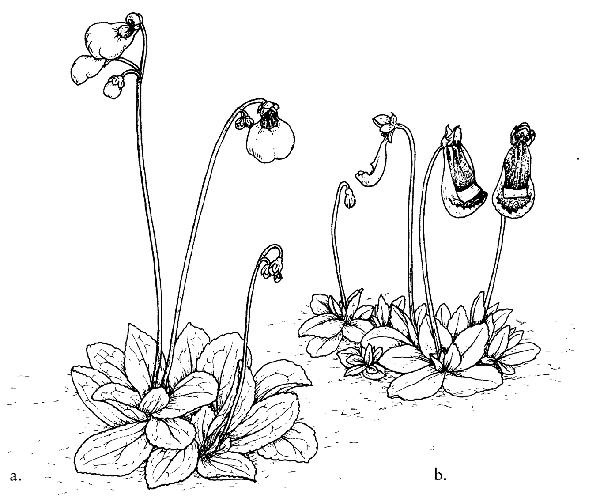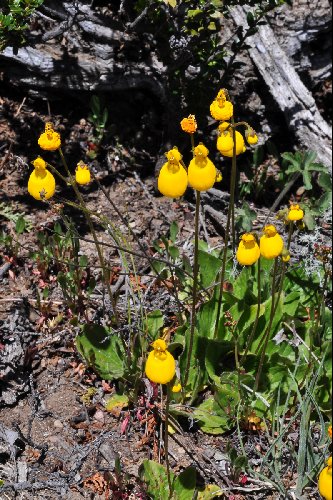Authors: Lam.
Clump to colony-forming with flowering stems 10-45cm tall, spreading by short, thick rhizomes. Leaves in clustered basal rosettes from oblong through broadly lanceolate and obovate to rhomboid, 2.5-10cm long. They are crenulate to dentate, blunt to fairly acute at the dp and wedge-shaped at the base with a winged petiole, white-hairy on the veins beneath. Flowers two to eight in loose racemes, the well inflated, rich yellow lower pouch
1.7 by 2cm in diameter, sometimes sparsely red-spotted around the throat. This represents the core species, itself highly variable, of a very difficult and widespread complex badly in need of expert revision. There is now general agreement that C. plantaginea and C. falklandica (the latter with an excepdonally long petiole equalling the blade) are no more than synonyms of C. biflora. C. palenae while yet another discarded synonym in the 'Flora of Chile' project, is considered by others to be a distinct species on account of its consistendy adpressed backward-facing hairs on the upper stems and calyx, its heavily flowered scapes and other floral details. Another variant with strongly lacerated rhomboidal leaves to 9cm long, sometimes downy on both surfaces, a long petiole, and many flowering stems is recognised in its own right either as C. biflora var. obtusiloba ('Flora of Chile') or as C. luxurians. It occurs in the north of the range. To confuse the issue still further the compilers of the 'Flora of Chile' accept C. flabellifolia as a separate entity. This has markedly fan-shaped leaves deeply slashed towards the apex, the divisions themselves again toothed. It is also said to have orange-yellow flowers. This plant is downgraded elsewhere to a mere synonym of C. luxuriansl Whatever its status, the C. flabellifolia plant sounds well worthy of horticultural investigation. The whole complex tends to form colonies in permanendy moist alpine and subantarctic habitats, lining snowmelt rivulets, damp grassy flushes, forest clearing etc. Flowering takes plant over a long period depending upon the altitude and latitude. Chile and Argentina from Catamarca to Tierra del Fuego, also the Falklands (rare) from sea level to 2800m.

a, C. biflora; b, C. uniflora var. darwinii;

Sign up for our newsletter to receive our monthly update direct to your inbox. Featuring our latest articles and news.
Built by Atomic Smash

